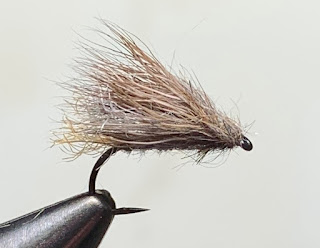This past Saturday I fished the South Branch of the Raritan River for a couple of hours in the afternoon and had a great time fishing dry flies. The river was a little low and clear as gin, the air was maybe 50F with a bright sun moving in and out of the clouds passing overhead. When I got there I was expecting ot see the black stoneflies on the water, but I wasn't expecting to see Hendricksons hatching so early in the season. Not a ton, but enough that the trout were focused on eating them over the more adundant stoneflies.
Of course, I didn't notice the Hendricksons at first, as there were plenty of stonesflies in the air and on the water and so that's what I initially set out to imitate with a #14 dark gray caribou caddis. I dropped the fly over rising trout only to have them ignore it time after time. My presentations didn't put the fish down, I thought I was getting a good drift, but the trout were having none of it and kept rising like I wasn't even there. So I stopped casting and got down low to reduce the glare coming off the water, and looked across the surface and saw a mayfly. I watched it drift along and sure enough a trout went out of its way to take it. I watched some more and much to my surprise I saw more of what turned out to be hendricksons, mostly red quills (males) but also a few of the larger hendricksons (females). So as not to disturb the good water, I waded downstream to a shallow run and stepped out into the current to grab one of the insects to positively identify it. Yep, a red quill! About 2 weeks earlier than we normally see them in this region of the Northeast.
(Red Quill)
I did not expect this at all; 50 years of trout fishing in New Jersey and I had never seen hendricksons hatching this early in the year. I have seen a random one here and there in late March over the years, but not enough to bring up fish. I also saw a single quill gordon, large and looking much like the female hendrickson, but a lighter body and only two tails. Hendricksons have three tails.Once I got back to the run where fish were rising to the duns, I tied a size #12 Catskill hendrickson to the end of a new, 3 foot long, piece of 5X tippet. I waited and watched until I saw a consistently rising fish and then with a quick cast I dropped my fly a couple of feet about the working fish. The fly dragged before it got to the target so I picked it up and made another cast, this time a strong reach cast, and that did it. The fly drifted right over the fish and it took it like candy. I brief fight ensued before I netted a nice rainbow.
A number of fish were working the run I was fishing, and a few casts later I hooked and landed another rainbow. The hatch pulsed as it usually does, with brief periods of flies coming off the water and fish taking them followed by a 5 to 10 minute period with few bugs and the fish presumably resting on the bottom waiting for another pulse. I wound up taking a bunch of cookie cutter rainbows and a nice brown trout.
And here's the one fly that did the trick. I took this one in the sun where it appears very light, but it isn't, as you can see in the second photo. The hackle and tail is from a rusty dun neck from Sidlinghill Hackle and the body is a mix of tan, pink and gray rabbit fur. When I have a good day with a fly, I cut if off and save it leaving some of the tippet so I have a momento from a good day on the water.
It looks like the hendrickson hatch is likely going to peak quite a bit early this year, perhaps before opening day in New Jersey. So if you go out you will have to fish special regulation waters which there are only a limited amount of; don't expect to be alone on the water.
Sharpen your hooks and give each other plenty of room on the water...it's just fishing.

